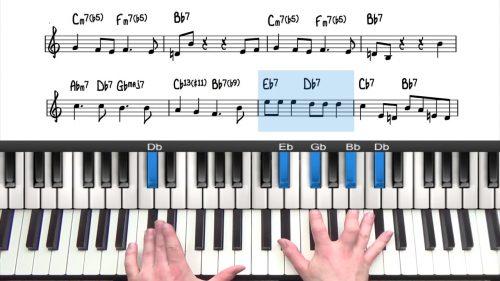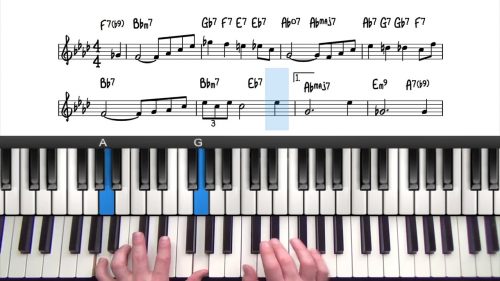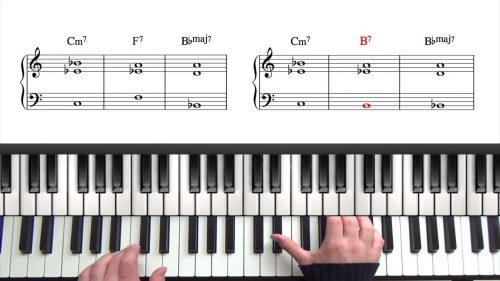Have Yourself A Merry Little Christmas Tutorial
Welcome to this tutorial on the Christmas Ballad “Have Yourself a Merry little Christmas”. The tune follows a 32 bar form, with a 4 bar extension at the end.
In part 1 of this tutorial we will create a full solo piano arrangement incorporating big 2 handed voicings, upper structure triads, passing chords and suspended harmony.
The melody of the tune is repetitive and so we will explore ways that we can add variety by utilising the different registers of the piano. We’ll also add in some interesting chord reharmonisations to spice up the repetitive chord changes.
In Part 2, we will then explore how to create intros and endings using the 1625 and it’s variations.
Practice Tips
-
When creating arrangements for Christmas tunes, try to harmonise every note of the melody... don't be lazy by just playing the chords from the lead sheet!
-
Use dominant passing chords built from a fifth above or a half step above the target chord.
-
Incorporate all of the registers of the piano... Play some of the phrases in the lower registers and then extend to the higher registers to add interest and variety to your arrangement.
-
Listen to both instrumental and vocal versions to gain inspiration for phrasing (and rephrasing!) the melody.





Hi, Hayden
I have a question.
In the bridge, the tune starts with Dbmaj7 and then goes to Dbm. You reharmonized the Dbm with Gb13(#11).
What is the reason for choosing Gb13(#11) ?
In the video, you said it’s “a straigth reharm.” and played the secod inversion of the Upper Structure off 9th.
So, I also like to know what the straight reharm is.
Thank you.
Toshihiro
https://uploads.disquscdn.com/images/6827afcba526c667c83b2eaac50471fba2c3c65d79882f826518668cbc0dc66a.jpg
love it when you played the chordal stuff – Hayden .. powerful-sounding chords really!
This was by far the toughest of all the jazz pieces I have played so far! I understand yr explanations when I hear them one by one, but there is just too much to absorb. I have take it all in in small doses. Otherwise my mind suffers from overload! But then later I forget most of it and have to replay the video. Memorisation also takes a long time.
This is also true to a lesser extent of many of the other pieces as well. I can understand yr explanations bc my music theory is pretty good. (I used to write short compositions for wind band). have also tried transposing some of the ones in C major to other keys like Bb. But I need to repeat them many times otherwise I forget.
Am I on the right track? Should I be doing something different? How long will it be before all this starts to come more naturally?
That said, I love yr patient explanations and the beautiful arrangements.
Just feeling frustrated
Bruce
Hi Bruce,
Great question!
I created these Xmas tutorials a number of years ago – in 2018 I think – and my goal at that time was to create very sophisticated Xmas arrangements with ‘all the bells and whistles’ in terms of passing chords, altered voicings, and other sophisticated harmonic devices.
In this lesson we arrange the tune very thoroughly in an attempt to demonstrate a wide variety of jazz theory areas and how they can be applied to songs. If today I wanted to play this arrangement exactly as I demonstrate in the lesson, I would also have to study my own lesson as I don’t play the Xmas repertoire often (just towards the holidays each year).
Last October I hosted a seminar where I showed how to play 3 jazzy Christmas songs in a continuous stream of music. You can find the seminar here:
https://www.pianogroove.com/live-seminars/jazzy-xmas-repertoire/
In this seminar we play “Have Yourself A Merry Little Xmas” in the key of C (instead of Ab which we cover in this tutorial) and I also try to explain the harmonic construction of the tunes so that it’s easier to memorise the basic chord changes.
You can transpose the Xmas tunes into C Major as I do in the seminar and I find this to make them a little easier to remember and also easy to create a continuous stream of holiday music.
In hindsight, I should have started this Xmas course with this kind of analysis, and then gradually layered in all of the ‘bells and whistles’. Currently this arrangement, and some of the others in this course, ‘jumps straight into the deep end’.
In my newest courses, such as “Misty Cocktail Piano Improv” – https://www.pianogroove.com/jazz-piano-lessons/cocktail-improvisation-for-beginners/ – I changed my way of teaching to start with the absolute basics and as each lesson progresses, we add an extra layer of sophistication.
Creating this new style of course has also helped my own playing of the tunes, as I find that I can always ‘drop back’ to basic voicings, instead of having to play sophisticated harmony all of the time.
In summary, what I am teaching here in this “Have Yourself A Merry Little Xmas” lesson is high-level harmony that even for myself is tricky to create/re-create ‘on the spot’ without prior planning/rehearsing and so it’s natural for you to find this tricky too.
So to answer your question… I recommend to check out the seminar above, learn the basic framework of these tunes, and in fact they can sound very beautiful just playing simple voicings with interesting melodic embellishments as I demonstrate in the seminar.
Use this as the base and go from there!
I hope that helps Bruce – please let me know if I can be of further assistance.
Talk soon, Hayden
Just a bit confused by your answer. There are already two other arrangements of “Have Yourself a Merry Christmas” in the Jazzy Christmas Lessons course, one of them for beginners and one a bit more advanced. Both of them are in C major. I worked through these before I got to the far more complicated A flat version. But the fact that you say that you deliberately made the A flat version very difficult – with all the “bells and whistles” – makes me feel a lot better. Since sending my previous message to you I have spent a lot of time on the A flat version now and can say that it is beginning to feel more comfortable under my fingers. Bottom line – if I can play and understand a deliberately tough arrangement like that(albeit very slowly!) then maybe I really am getting somewhere! Anyway, I have decided to return to the easier arrangements in the course and learn them more thoroughly by transposing them into different keys. I will also do this with the beginner course that I completed a while back. Hopefully, this will give me a more solid grounding before I try something new. Meanwhile, I want to say how much I appreciate your feedback. I really love the fact that you actually respond when I ask a question. Despite my frustrations, I am actually a great fan!! Bruce
Hey Bruce,
Apologies for the confusion. Indeed I have covered this tune in the key of “C” in the beginner module of this course. I expand upon this arrangement in the seminar referenced and so do check that out.
Yes the main goal of these lessons is that you understand the theory and how it is applied so you are very much on the right path. This is the first step to being able to apply this theory in a more spontaneous and intuitive manner. Just like learning to speak a language, it takes time.
Yes being able to play through these songs with basic spread/shell voicings and tasteful melodic embellishments is very enjoyable too.
I’d say both skills are equally important. Whilst I really enjoy exploring advanced jazz harmony, it can be nice to play a ‘stripped-back’ version and selectively choose when and where to add more interesting harmonic devices.
My pleasure, thanks Bruce!
Each year I add more lessons to our Xmas courses and so more to come!
More recently I have been exploring blues piano and so my most recent Xmas lessons have a blues focus, you can find them here: https://www.pianogroove.com/jazz-piano-lessons/christmas-song-improvisation/
Talk soon, Hayden